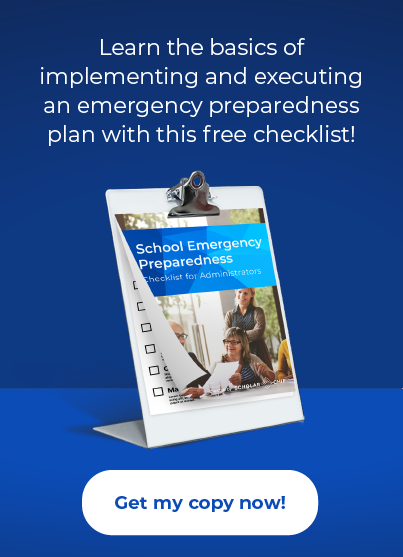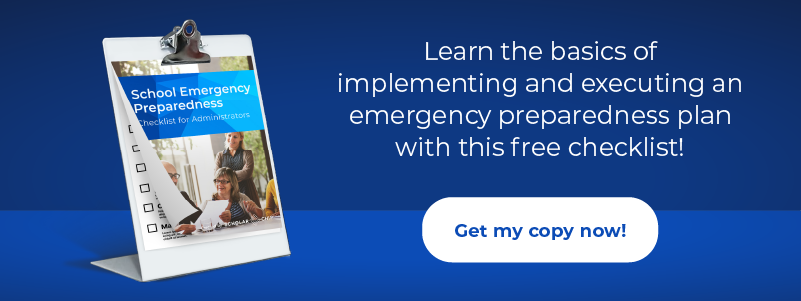Parents and communities trust their schools to maintain an educational environment that lets students achieve success. Part of that expectation is for the school environment to be safe—and part of keeping students safe includes planning for the worst.
That’s why schools pour hours into the creation of a school emergency plan. It involves input from experts and interested parties and clarifies expectations around threats and disasters. However, the development of this plan is only the beginning. Threats evolve and responses to disasters improve.
Remember that your school’s emergency plan is a blueprint for how to handle crisis situations.
Your school’s emergency plan should be re-evaluated and updated yearly. In the wake of the COVID-19 pandemic, you’ll have much to consider during this year’s review.
Evaluate Your Current Emergency Plan
The act of re-evaluating your school’s emergency plan must involve different perspectives and expertise. This isn’t something that can be completed by just you or another member of staff. As with its initial development, forming an Emergency Preparedness Committee or Collaborative Planning Team should be your first step. This team should include members from within the school and the community to provide a broad perspective.
Once you have your team identified, gather information about the threats and hazards that you need to consider. Are there new threats? Have changes in the school or community increased exposure to hazards? For instance, if you’ve expanded your chemistry class’s curriculum, are there new chemical hazards that weren’t accounted for in your previous version?
Next, re-evaluate your goals and objectives for the existing items and any new ones. For instance, what is your goal in the case of a weather-related shutdown? Is it educational continuity? Rapid response to grounds clearing?
Your review should also include the efficacy of your defined course of action. Does your current plan meet your goals of quickly notifying students and parents of shutdowns? Did you have the right tools and solutions in place to quickly respond to COVID-19 stay-at-home orders?
Review time is also an opportunity to expand and refine the emergency plan. While early versions may have focused on continuity or reactionary actions, this review can open the door to more proactive measures. For instance, it is a good time to understand and institutionalize school environment strategies, like Positive Behavioral Interventions, as part of your school’s overall safety plan.
Who Should Be Part of the Update Process?
Having the right people in the metaphorical room will make the process of updating your school’s emergency plan go smoothly, as well as guarantee that you’ll cover all the appropriate bases for planning.
Your core planning team should consist of yourself and other school staff and administrators, board members, and medical personnel, such as your school’s nurse.
You should also include individuals with specialized viewpoints. Specifically, your team should have a member who can speak to the needs of special education students. Additional specialized team members include representatives for first responders, such as the fire department and law enforcement.
In addition to the core team, a committee of parents may be able to provide insight into the families’ perspectives and give them a voice as part of the process as well.
What Should Be Included in Your School’s Emergency Plan?
A proper emergency plan will cover threats and hazards that are likely, such as snowstorms or power outages, as well as those that are unlikely but serious.
Natural Disasters
Emergency planning for natural disasters is a given. You’ll want to have plans for weather and other natural events that are appropriate for your climate and location.
Depending on the part of the country you’re located in, you’ll want to include and update your response plans for tornadoes, hurricanes, earthquakes, lightning, floods, wildfires, extreme temperatures, landslides, and/or severe winter storms.
Verify that you’re tying all the actions for these disasters back to goals. If educational continuity is a goal during weather events, will you extend the school year for missed days, or can you use remote learning resources? Do those resources make sense for some disasters, like snow days, but not others, like severe storms when many students could lose power?
Active Shooters, Incident Response, and Other Human-Created Threats
While active shooter drills have gotten a great deal of attention, they are only one facet of the category of human-centered threats that should be included in your school’s emergency plan.
This category could include everything from crises that involve a large number of students, like bomb threats, fires, and gang violence, to more individualized and personal incidents, like suicides. Even technological threats, like cyber attacks, should be taken into account as part of your plan.
When reviewing your action plan for human-centered threats, be sure to take into account any new technologies that can help during an incident. For instance, smart card technologies that identify who has accessed the campus, as well as when and how, can provide valuable access data. Visitor management technologies also provide key information, especially for law enforcement.
Explosions and Hazardous Materials
Updating your school’s emergency plan is a good opportunity to ensure that you’re taking into account any threats presented by new materials within the school or refining communication and management protocols that align with new notification procedures or technologies.
Reviewing this section with first responders can also be critical. Is it time to retrain any staff responsible during an explosion? Do fire or police departments have new protocols for hazardous material handling? These updates should be incorporated into your refined plan.
Biological Hazards, Including Infectious Diseases
COVID-19 has brought infectious disease response to the forefront for administrators. In the wake of the recent pandemic, there are likely to be lessons learned and items from after-action reviews that should be folded into your school’s emergency plan.
Don’t make the mistake of ignoring other biological hazards as you focus on the most recent incidents, however. There are many other hazards to be considered and reviewed, including action plans for other infectious diseases, contaminated food outbreaks, and even toxic materials used in school labs or by maintenance staff.
Provisions for Emotional and Psychological Support
You may not have a section of your plan dedicated to emotional and psychological support during these crises. But as you review and update your plan, it’s an ideal time to consider where and how you can provide these resources in the wake of a disaster or threat.
Refined emergency plans should take into account the needs of students and staff. They should also lay the groundwork for immediate counseling needs, as well as long-term support. As you mature your emotional and psychological support responses, adding in plans for long-term behavioral monitoring and positive supports is appropriate.
What Are the Next Steps in Updating Your Plan?
After reviewing and updating goals and actions in your school’s emergency plan, it’s time to revisit your emergency preparedness budget against the needs you’ve identified. Start to mitigate response gaps by preparing an RFP for the products and solutions you’ll need.
Training is also an essential part of preparedness. Verify that those with roles as part of the plan understand what’s expected of them and their responsibilities. Schedule any re-certification or refresher courses as needed.
Simulations, drills, and testing of your existing plan and new actions should also be scheduled. Remember that live-action simulations take longer to plan and coordinate and that tabletop exercises should include those with critical roles. Plan to test communication systems too, since you won’t want to discover a system failure in the middle of a crisis.
Your emergency plan is at the core of keeping students safe during the most detrimental events. Reviewing and updating it is as important as its initial creation. As you conduct your review, include the right representatives in your planning team, and verify that they represent the various areas of the school community. Ensure that the right threats and hazards are accounted for, that the goals are clear, and that new solutions and technologies are considered. Include plans for training and simulations and tests of critical systems. Completing your review now will have you ready for the new school year, as well as position you to do the research and analysis needed to fill any gaps you find during your evaluation.
ScholarChip offers holistic school safety services aligned with CDC guidelines to help schools reopen amidst growing health concerns. Through our advanced technology, built and designed for the K-12 environment, schools can identify risks and mitigate the spread of infection. Our solutions include fever screening, visitor surveys, symptom and vaccine tracking, in-school contact tracing, alerts and notifications. Learn more about our advanced COVID-19 solutions or request a reopening strategy session today!


